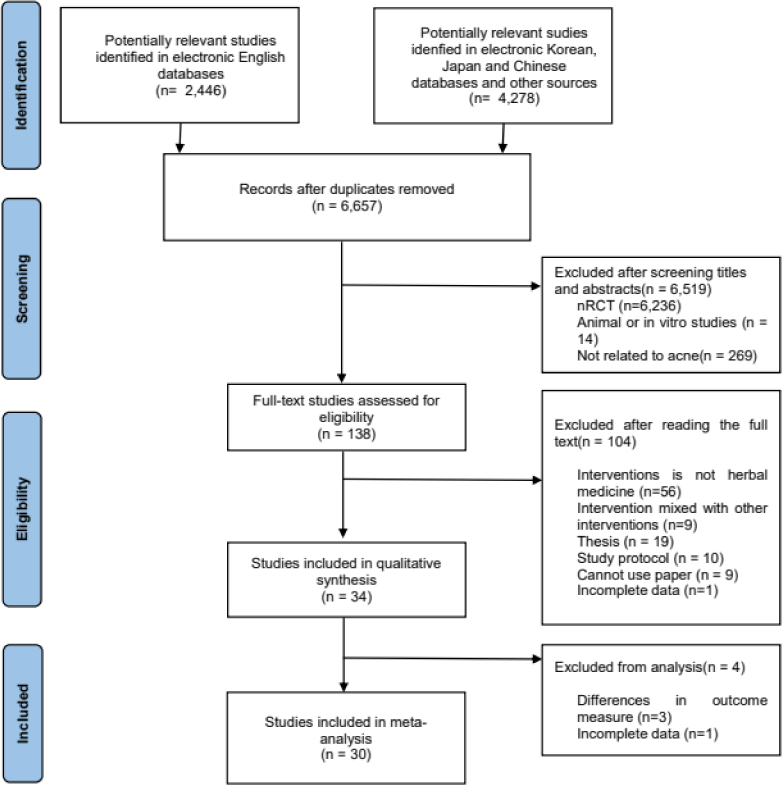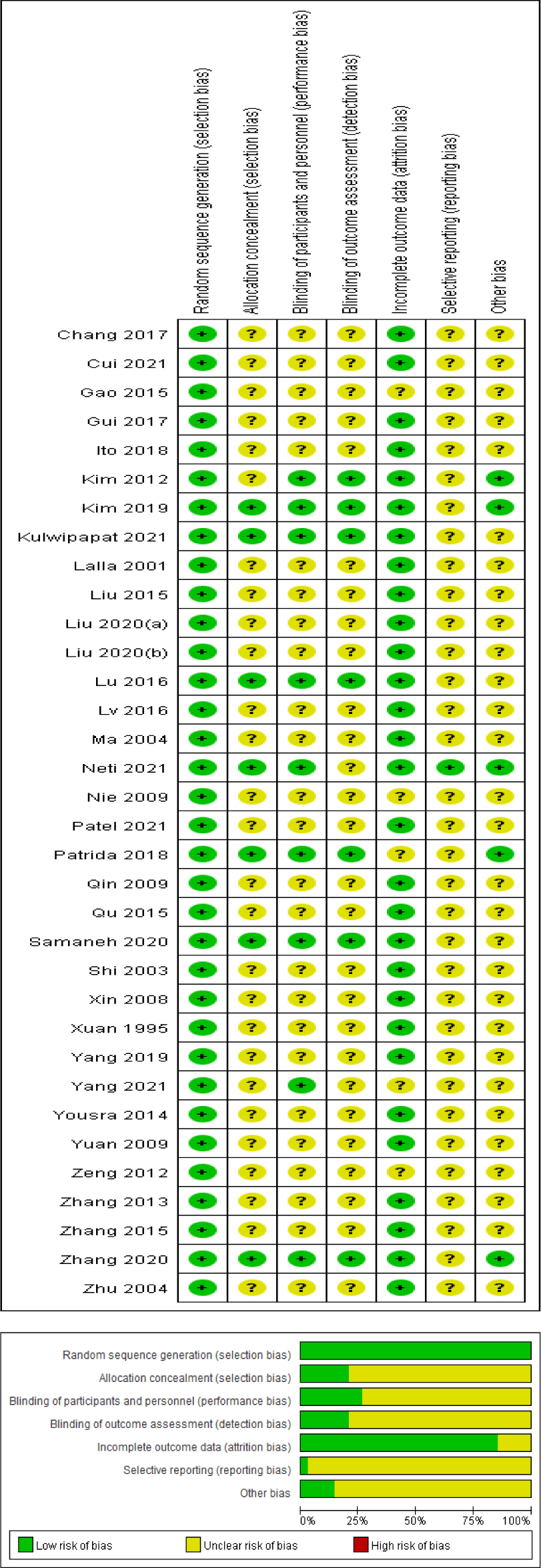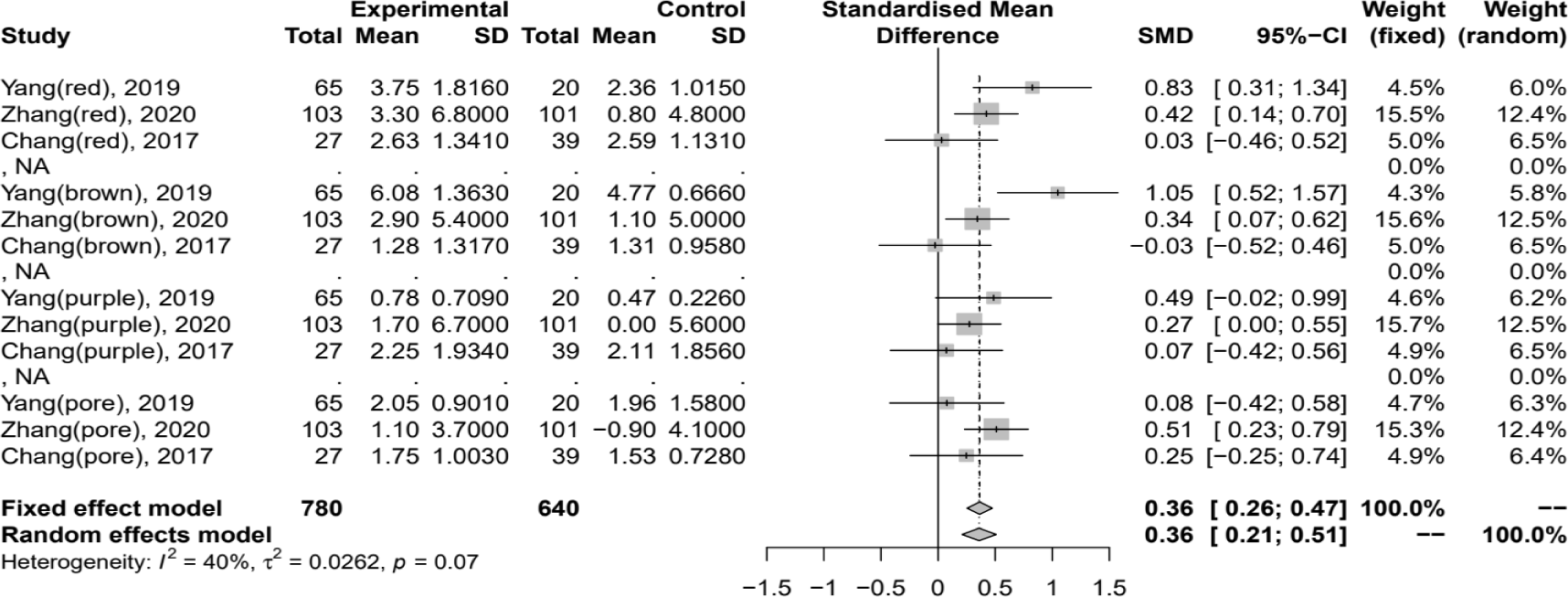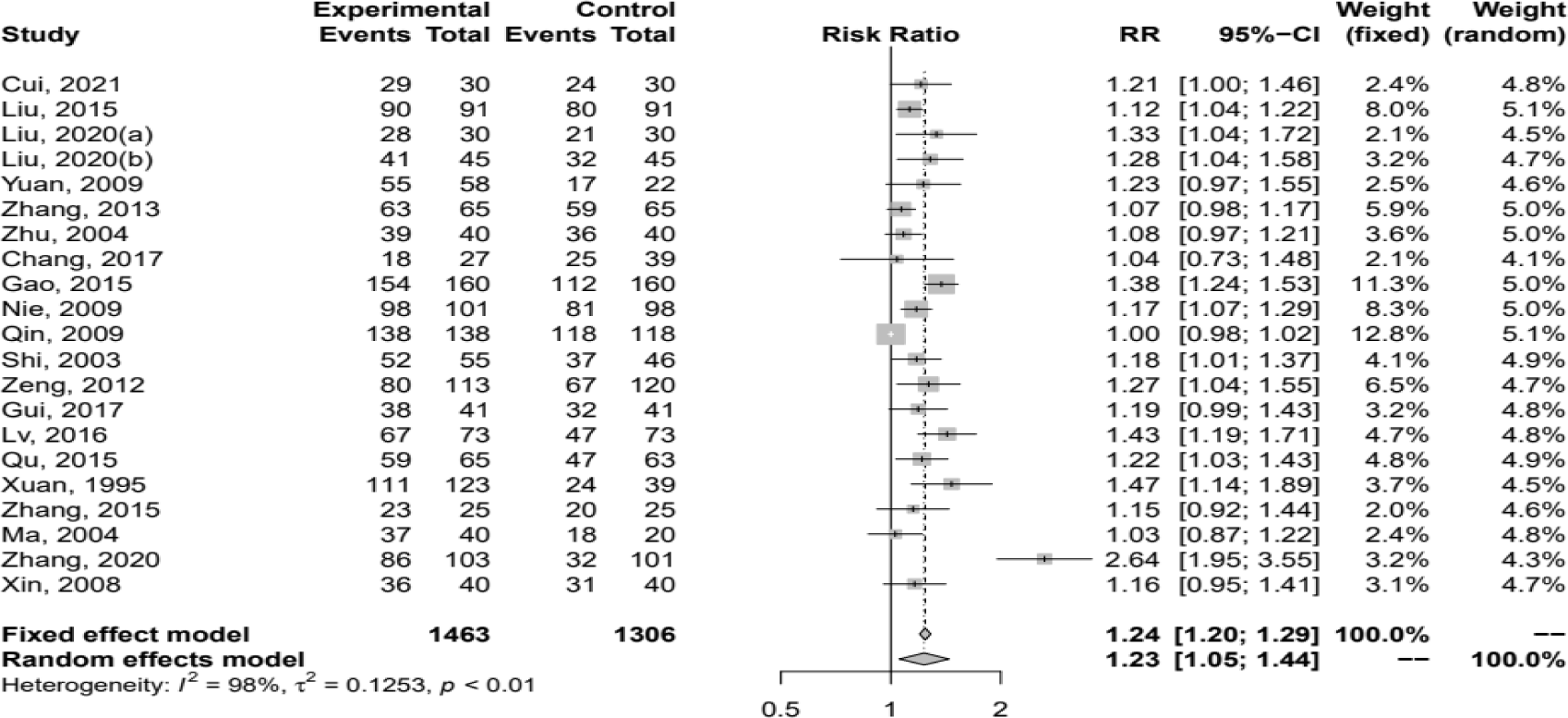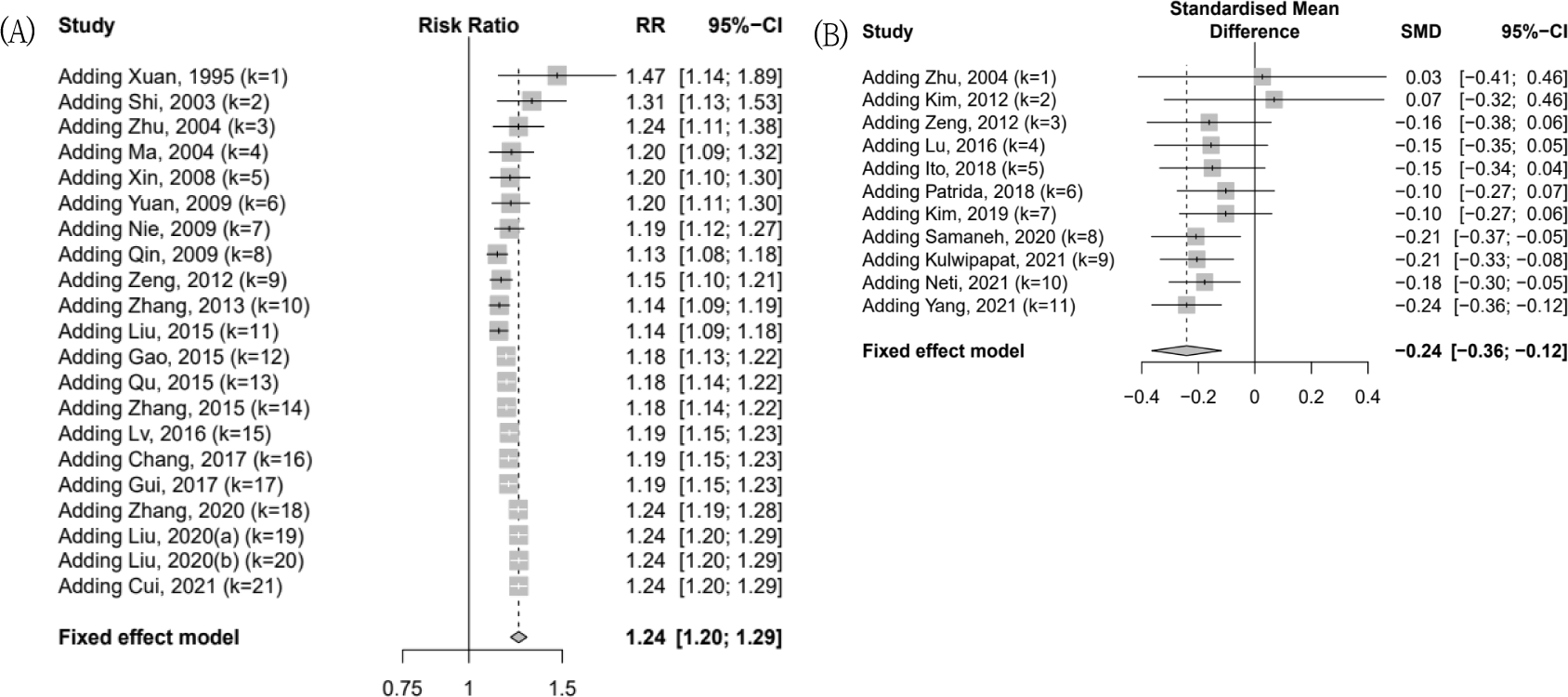Ⅰ. 서 론
여드름은 대부분 호르몬의 변화가 일어나는 청소년기에 시작되는 피부부속기의 염증성 질환으로, 피지선이 발달하면서 피지분비의 증가, 비정상적인 표피층의 정체와 과각화, 모낭 내 상주 박테리아인 Propioni-bacterium acnes의 증식과 염증반응 등 다양한 원인으로 발생한다1). 사춘기 이후에 성인에서 발생하는 여드름은 안드로겐에 의해 피지가 배출되는 상태에서 스트레스, 생리, 임신, 화장품 등 내외적인 유발요인이 생기면 언제든지 악화할 수 있다2).
보건의료빅데이터시스템의 2010년부터 2020년까지 10년간 자료에 따르면 여드름으로 치료를 받은 환자의 수가 뚜렷하게 증가하는 경향을 보였다3). 현재 한방 의료기관(한방병원, 한의원)에서 시행되고 있는 여드름 치료는 주로 한약 복용과 외용 한약을 포함한 외과적 치료가 이루어지고 있다. 한약 복용으로 여드름을 치료한 김 등4)의 연구에서는 한약 복용으로 여드름을 치료하여 좋은 효과를 나타내었고, 조 등5)의 연구에서는 251개의 증례에서 27개의 각기 다른 처방을 사용하여 좋은 효과를 나타내었으며, 이때 각각의 증례에 따라 외용 치료를 병행한 경우도 다양하게 존재하였다. 최 등6)의 연구를 살펴보면 顚倒散이 여드름 유발균인 Propioni-bacterium acnes에 대한 항균 및 항염증에 효과가 있는 것을 밝혔고, 홍 등7)의 연구에서 顚倒散이 임상적인 효과가 있음을 발표하였다. 윤 등8)의 연구에서는 트립토판(Tryptophan)과 리보플라빈(Riboflavin)을 광과민제로 사용하는 광역동치료(Photodynamic therapy)를 이용한 여드름에 대한 한의 치료의 효과를 보여주었다. 이 등9)은 하니매화레이저를 이용한 여드름 흉터 치료, 진피절제술(subcision)의 원리에 근거한 도침요법, 자락사혈 등의 한의치료법을 활용한 위축성 여드름 흉터 치료10,11) 등의 내용을 발표하였다.
이와 같이 국내의 한의학계에서는 여드름에 대한 연구가 이루어져 왔으나, 아직까지 무작위 대조군 임상연구들을 대상으로 한 체계적 문헌고찰과 메타분석이 이루어지지는 않았으므로, 이에 저자는 본 연구를 계획하게 되었다. 본 연구를 통해 한약의 여드름 치료 효과를 살펴 향후 임상에서 적용할 수 있는 근거와 기준안을 제시하고, 치료에 도움이 되고자 하였다.
Ⅱ. 방 법
문헌 검색은 전자 데이터베이스(Database, DB)가 자료를 지원하는 시점부터 2021년 10월까지의 검색 결과를 이용하였다. PubMed(www.ncbi.nlm.nih.gov/pubmed), WoS(Web of Science, https://mjl.clarivate.com/home), EMBASE(Elsevier, https://www.embase.com/), 한국 의학 DB인 RISS (Research Information, http://www.riss.kr/index.do)와 KISS(Korean Studies Information Service System, https://kiss.kstudy.com/), 중국 의학 DB인 CAJ(https://www.cnki.net/), 일본 의학 DB인 CiNii(https://cir.nii.ac.jp/)를 사용하여 수행하였다. 주요 검색어로는 MeSH 검색이 되는 DB는 ‘Acne’, ‘Herbal Medicine OR Herbal Extract’, ‘Korean Medicine’, ‘Chinese Medicine’, ‘Kampo Medicine’, ‘Randomized Controlled Trial OR Randomized Clinical Trial’로 검색하였다. 각 DB 언어로도 변환하여 ‘여드름’, ‘한약’, ‘무작위 대조 연구’, ‘痤瘡’, ‘中药’, ‘随机’로 검색하였다. 연구의 출판된 언어를 제한하지 않았다.
무작위 대조 연구 시험(Randomized Controlled Trial), 무작위 대조 임상 시험(Randomized Clinical Trial)을 포함하였다. 통제되지 않은 연구(비무작위 대조연구), 문헌 고찰, 증례연구, 여드름을 평가 지표로 본 연구, 동물실험 및 in vitro, 학위 논문 연구 등은 제외하였다. 치료 기간에는 제한을 두지 않았다.
연구를 선정하는 과정에서 두 명의 작성자가 독립적으로 사전 정의된 형식에 따라 데이터를 추출하였다. 전자 DB에서 연구를 검색하고 제목과 초록을 바탕으로 해당하는 연구를 선정하였다. 혼란이 있는 경우 토론을 통해 의견이 일치되도록 노력하였으며, 해결되지 않는 경우 지도교수의 도움을 받아 논문을 선정하였다.
한약 치료군으로서 첫째, 한약 복용 치료(Oral Herbal Medicine, OHM), 둘째, 한약 외용 치료(External Herbal Medicine, EHM), 셋째, 한약 복용과 한약 외용의 동시 치료를 시행한 연구(Oral Plus External Herbal Medicine, OEHM)를 포함하였다. 침 치료, 광선치료 등 기타 다른 중재 방법이 복합된 연구는 제외하였다. 대조군은 무처치(Nothing), 위약(Placebo), 양약(Western Medicine, WM)이었다. 중재 방법에 사용된 한약의 종류, 제형, 복용량 또는 치료 기간에는 제한을 두지 않았다.
첫째, 치료자가 주관적으로 평가하는 항목인 염증성 여드름 병변 개수(Inflammatory Lesion Count)와 비염증성 여드름 병변 개수(Non Inflammatory Lesion Count), IGA(Investigator’s Global Assessment), 둘째, 기계 평가인 VISIA(Facial Imaging System), 셋째, 환자들이 주관적으로 평가하는 DLQI(Dermatologic Life Quality Index), 유효율(Effective Rate), 재발률(Recurrence Rate)과 부작용(Adverse Events) 등을 사용하였다.
질 평가는 비뚤림(Bias)의 위험을 평가하는 것으로 최종 선정된 연구들을 무작위 실험연구 평가도구인 Cochrane Collaboration’s Risk of Bias(Rob)12)를 사용하여 평가하였다.
메타분석을 수행하기 위해 Review Manager 5.4 (RevMan, Cochrane Collaboration Software)과 R 4.1.0의 Meta, Metafor 프로그램13)을 이용하여 분석하였다. Chi-square test와 Higgins I2 검정을 사용하여 이질성을 평가했으며, I2값이 50%보다 크거나 p값이 0.1보다 작은 경우 연구간에 이질성을 보이는 것으로 평가하였다14). Cumulative Plot을 이용하여 누적 메타분석을 시행하였고, 연구의 강건도(Robustness)를 평가하기 위해 민감도 분석(Sensitivity Plot)과 Baujat Plot을 사용하였다. 또한 Funnel Plot과 Egger’s regression을 활용하여 출판 비뚤림 여부를 확인하였다.
Ⅲ. 결 과
문헌 선정 검색어를 이용해 국내, 국외 전자 DB를 검색한 결과 전체 6,724편의 문헌이 검색되었다. 중복된 문헌을 제거 후 6,657편에서 제목과 초록을 확인하여 RCTs 연구가 아닌 것 6,236편, 동물 및 In vitro 연구 14편, 여드름을 보기 위한 논문이 아닌 것 269편을 제거하고 138편의 논문을 검토하였다. 그중 한약 치료가 아닌 것 56편, 중재 방법이 한약 치료 외에 다른 치료가 포함된 복합적인 것 9편, 학위 논문 19편, Protocol 연구 10편, 원문을 볼 수 없는 연구 9편, 논문에 데이터 오류가 있는 연구 1편을 배제한 결과 최종적으로 34편의 논문이 선정되었다. 34편의 논문으로 문헌 고찰을 시행하였으며, 평가 지표가 일치하지 않거나, 데이터의 불충분으로 분석에 포함할 수 없는 논문 4편을 제외하고 30편의 논문으로 메타분석을 시행하였다(Fig. 1).
선정된 34편의 연구의 처방(사용 약재), 샘플 크기, 치료군 및 대조군 중재 방법, 치료 기간, 평가 지표, 주요 결과값, 이상반응 등을 고찰하였으며 각 논문의 일반적 특성 내용은 표로 나타내었다(Table 1).
| First author (years) | Herb | Sample size (randomized/analysed) | Experimental group (intervention, regimen) | Control group (intervention, regimen) | Outcome measures | Main results | Adverse events |
|---|---|---|---|---|---|---|---|
| Kim(2019)15) | Cheongsangbangpoong-tang | 56/56 | (A) OHM(n*=28, 3times per day for 14d†) | (B) Placebo(n=28, 3times per day for 14d) | (1) Inflammatory lesion count (2) Non-inflammatory lesion count (3) NRS (4) IGA (5) KAGS (6) Cortisol and DHEA-S |
(1) Significant difference (A) but not in (B) (2), (3), (4), (5), (6) No significant |
Abnormality AST/ALT(A;1, B;1) |
| Kim(2012)16) | Keiagirengyoto Extract | 22/22 | (A) OHM(n=11, 3times per day for 28d) | (B) Nothing(n=11) | (1) Inflammatory lesion count (2) Non-inflammatory lesion count (3) Skindex-29 (4) IGA |
(1), (3), (4) No significant (A) and (B) (2) Significant difference (A) but not (B) |
(A;0, B;0) |
| Ma(2004)17) | Qingre Cuochuang Tablet | 60/60 | (A) OHM(n=40, 3times per day for 1m‡) | (B) Spironolactone, metronidazole, tetracycline (n=20, 3times per day for 1m) | (1) Effective rate (2) Serum Testosterone, Estiradiol |
(1), (2) No significant difference | Slight diarrhea(A;2) Nausea, abdominal pain(B;5) |
| Patel(2021)18) | Amalaki extract | 24/24 | (A) OHM(n=12, 2times per day for 60d) | (B) Placebo(n=12, 2times per day for 60d) | (1) Skin hydration (2) Acne global severity score (3) DLQI (4) IgE (5) Total antioxidant capacity |
(1),(2),(4),(5) Significant difference (A) but not in (B) (3) No significant |
(A;0, B;0) |
| Ito(2018)19) | Keiagirengyoto | 64/58 | (A) OHM(n=33, 3times per day for 12w§) + antimicrobial agents(clindamycin gel or nadifloxacin cream) | (B) Antimicrobial agents(clindamycin gel or nadifloxacin cream)(n=31, 12w) | (1) Inflammatory lesion count (2) Non-inflammatory lesion count |
(1), (2) No significant | Exacervated rash(A;1) Dry skin, erythema, cold, xerotic eczema(B;4) |
| Liu(2020)(a)20) | TCM prescription | 60/60 | (A) OHM(n=30, 2times per day for 6w) + benzoyl peroxide gel | (B) Tanshinone capsules(n=30, 3times per day for 6w) benzoyl peroxide gel | (1) Effective rate (2) Recurrence rate |
(1), (2) Significant difference (A) but not in (B) | Diarrhea(A;2, B;2), skin allergies(B;6) |
| Liu(2020)(b)21) | Jiedu Qudou | 90/90 | (A) OHM(n=45, 2times per day for 8w) + tretinoin cream | (B) Tretinoin cream(n=45, once a day) | (1) Effective rate (2) Recurrence rate |
(1) , (2) Significant difference (A) but not in (B) | Nm∥ |
| Yang(2019)22) | Qingre Chushih Decoction | 85/85 | (A) OHM(n=65, 2times per day for 4w) | (B) Nothing(n=20) | (1) VISIA | (1) Significant difference (A) but not in (B) | Nm |
| Lu(2016)23) | Green tea Extract | 80/64 | (A) OHM(n=40, 3times per day for 4w) | (B) Placebo(n=40, 3times per day for 4w) | (1) Inflammatory lesion count (2) Non-inflammatory lesion count (3) CADI (4) Lab |
(1) Significant difference (A) better than (B) (2), (3) No significant (4) Only total cholesterol is significant difference in (A) |
Mild constipation, abdominal discomfort(A;3) Thirsty, difficulty asleep(B;2) |
| Cui(2021)24) | Qinggan Qucuo Decoction | 60/60 | (A) OHM(n=30, 2times per day for 8w) + isotretinoin soft capsules(2times per days for 8w) | (B) Isotretinoin soft capsules(n=30, 2times per day for 8w) | (1) Score(number, shape, type of skin lesion) (2) Effective rate |
(1), (2) Significant difference (A) but not in (B) | Dry mouth, cheilitis, diarrhea, rough skin(A;2, B;7) |
| Liu(2015)25) | Jiedu Xiaocuo Soup | 182/182 | (A) OHM(n=91, 2times per day for 4w) | (B) Vitamin capsule(n=91, 3times per day for 4w) | (1) Effective rate | (1) Significant difference (A) but not in (B) | Nausea(A;1, B;2) Dry mouth, tongue problem, drowsy(B;7) |
| Yuan(2009)26) | Xiaochuangyin | 80/80 | (A) OHM(n=58, 2times per day for 20d) | (B) Oral isotretinoin(n=22, 2times per day for 20d) | (1) Effective rate | (1) Significant difference (A) but not in (B) | Nm |
| Zhu(2004)27) | Xiaocuoyin | 80/80 | (A) OHM(n=40, 2times per day for 6w) | (B) Retinoate capsules(n=40, 3times per day for 6w) | (1) Inflammatory lesion count (2) Non-inflammatory lesion count (3) Effective rate |
(1), (2) Significant difference (A) and (B) (3) Significant differecne (A) better than (B) |
Dry mouth, dry skin, lips desquamation(A;0, B;7) |
| Zhang(2013)28) | Qingfeiyin | 130/130 | (A) OHM(n=65, 2times per day for 2w) + clindamycin gel | (B) Clindamycin gel(n=65, 2times per day for 2w) | (1) Effective rate (2) Recurrence rate |
(1), (2) Significant difference (A) but not in (B) | Increased stool frequency(A;3, B;0) |
| Patrida(2018)29) | Herb extract(gel) | 77/77 | (A) EHM(n=39, 2times per day for 12w) | (B) Benzoyl peroxide(n=38, 2times per day for 12w) | (1) Inflammatory lesion count (2) Non-inflammatory lesion count (3) Adherence (4) Porphyrin (5) DLQI (6) Satisfaction |
(1), (2), (3), (4), (5), (6) No significant difference between (A) and (B) both significantly improved. | Glazing, cracking, erythema(A;5, B;14) |
| Neti(2021)30) | Herb extract (hydrogel) | 60/60 | (A) EHM(n=30, 2times per day for 28d) | (B) Clindamycin gel(n=30, 2times per day for 28d) | (1) Inflammatory lesion count (2) ASI (3) Redness and melanin value |
(1), (3) Significant difference (A) but not in (B) (2) No significant |
(A;0, B;0) |
| Yousra(2014)31) | Herb extract(cream) | 50/50 | (A) EHM(n=25, 2times per day for 45d) | (B) Benzoyl peroxide(n=25, once per day for 45d) | (1) Cook’s acne grading system (2) Improvement scale(1 to 5) |
(1), (2) No significant difference | Redness, swelling(A;0, B;17%) |
| Kulwipapat(2021)32) | Herb extract (water-soluble herbal acne patch) | 49/49 | (A) EHM(n=49, once per day from 8 PM to 6 AM for 11d) | (B) Hydrocolloid acne patch(n=49, once per day from 8 PM to 6 AM for 11d) | (1) Median time to resolution (2) Diameter, erythema score, lightness score (3) Physical satisfaction scale(1 to 5) (4) Inflammatory lesion count |
(1), (2), (4) Significant difference (A) more than (B) | (A;0, B;0) |
| Samaneh(2020)33) | Herb extract (hydrogel) | 60/60 | (A) EHM(n=30, 2times per day for 60d) | (B) Placebo(n=30, 2times per day for 60d) | (1) IGA (2) Number of acne lesions (comedos, papules, pustules) (3) ADI |
(1) , (2), (3) Significant difference (A) but not in (B) | (A;0, B;0) |
| Yang(2021)34) | Herb extract (cleanser) | 60/60 | (A) EHM(n=30, 2times per day for 8w) | (B) Vehicle(n=30, 2times per day for 8w) | (1) Inflammatory lesion count (2) Non-inflammatory lesion count (3) IGA (4) IL-1, IL-8, TNF-α, keratin 16 |
(1) , (2), (4) Significant difference (A) but not in (B) except TNF-α (3) No significant |
Burning sensation, prickling, dryness(A;6, B;3) |
| Gao(2015)35) | Herbal medicine (fumigation) | 320/320 | (A) EHM(n=160, once per day for 2m) | (B) Tretinoin cream(n=160, 2times per day for 2m) | (1) Effective rate | (1) Significant difference (A) but not in (B) | Itching, scaling, redness(A;6, B;12) |
| Nie(2009)36) | Herbal medicine (liquid) | 199/199 | (A) EHM(n=101, twice per day for 4w) + tretinoin cream(once) | (B) Tretinoin cream(n=98, once per day for 4w) | (1) Effective rate (2) Acne, papules pimples, nodules |
(1) Significant difference (A) but not in (B) (2) No statistical analysis |
Redness, scaling(A;0, B;2) |
| Zeng(2012)37) | Herbal medicine (powder, facial mask) | 233/233 | (A) EHM(n=113, twice per week for 4w) | (B) Benzoyl peroxide gel(n=120, once per day for 4w | (1) Lesion count (2) Effective rate |
(1), (2) Significant difference (A) more than (B) | (A;2, B;3) |
| Zhang(2020)38) | Herbal medicine (powder) | 220/204 | (A) EHM(n=110, once per day for 4w) | (B) Placebo(n=110, once per day for 4w) | (1) ASS (2) Effective rate (3) DLQI (4) VISIA scroe (5) Skin assessment |
(1), (2) Significant difference (A) but not in (B) (3), (4), (5) Significant difference (A) more than (B) |
Allergy(A;2, B;0) |
| Chang(2017)39) | Herb extract (ointment) | 186/186 | (A) EHM(n=27, once per day for 4w) | (B) EHM+fusidic acid+minocycline hydrochloride(n=56, apply once per day for 4w, intake 2times per day for 4w) (C) Fusidic acid(n=39) (D) Fusidic acid +minocycline hydrochloride(n=64) |
(1) GAGS (2) Effective rate (3) VISIA |
(1) Statistically difference all groups. (2) No statistical difference all groups. (3) No significant difference between (A), (B), (C) and (D) all groups were significantly improved. |
(A;0, B;0) |
| Qin(2009)40) | Herbal medicine (liniment pour mask) | 256/256 | (A) EHM(n=138, twice per day for 8w) + isotretinoin | (B) Isotretinoin(n=118, twice per day for 8w) | (1) Effective rate | (1) Significant difference (A) more than (B) | Dry skin, scaling, erythema(A;5, B;4) |
| Shi(2003)41) | Herbal medicine (powder facial mask) | 101/101 | (A) EHM(n=55, once every other day for 4w) | (B) Chloramphenicoltincture ointment(n=46, twice per day for 4w) | (1) Effective rate | (1) Significant difference (A) more than (B) | Nm |
| Lalla(2001)42) | Herb extract (soft tablets, cream, gel) | 53/46 | (A) OHM + EHM(n=23, tab+gel, twice per day) (B) OHM + EHM(n=23, tab+cream, twice per day) |
(C) OHM + placebo(n=5, tab+placebo, twice per day) (D) Placebo + Placebo(n=2, twice per day) |
(1) Global assessment scale(Burke and Cunliffe) | (1) (A), (B) was statistically significantly better than (C), and (B) was better than (A). | Itching, increase in gastric motility(undisclosed by group) |
| Lv(2016)43) | Herbal medicine + herbal medicine mask | 146/146 | (A) OHM(n=73, twice per day) + EHM(twice per week for 6w) | (B) Vitamin capsules(n=73, twice per day) + pdt(twice per week for 6w) | (1) Effective rate (2) Serum Toll-like receptor-2, TNF-α, testosterone, estradiol levels |
(1) Significant differecne (A) but not in (B) (2) Significant difference (A) more than (B) |
Erythema, itching, pain, sacling, nausea(A;8, B;16) |
| Gui(2017)44) | Yinqiao powder + washing | 82/82 | (A) OHM + EHM(n=41, twice per day for 2w) | (B) Adapalene gel(n=41, twice per day for 2w) | (1) Effective rate | (1) (A) significantly higher than (B) | (A;0, B;0) |
| Zhang(2015)45) | Herbal medicine (internal + external) | 50/50 | (A) OHM + EHM(n=25, twice per day for 20d) | (B) Roxithromycin, retinolide+retinoide oint(n=25, twice per day for 20d) | (1) Effective rate | (1) Significant differecne (A) but not in (B) | Nm |
| Qu(2015)46) | Herbal medicine (internal + external) | 128/128 | (A) OHM(n=63, twice per day) + EHM(once per week for 6w) | (B) Roxithromycine + vitamin E cream(n=65, twice per day) | (1) Effecitve rate | (1) Significant differecne (A) but not in (B) | Gastrointestinal reaction(A;0, B;2) |
| Xin(2008)47) | Herbal medicine (internal + external) | 80/80 | (A) OHM(n=40, twice per day) + EHM(twice per day) *mild and moderate patients is 2 to 3w, and for severe patients, 6 to 8w. |
(B) OHM(n=40, twice per day) *mild and moderate patients is 2 to 3w, and for severe patients, 6 to 8w. |
(1) Effecitve rate | (1) Significant differecne (A) but not in (B) | (A;0, B;0) |
| Xuan(1995)48) | Xiaozuo Ling Herbal medicine (internal + external) | 163/162 | (A) OHM(n=123, twice per day) + EHM(3times per day for 28d) | (B) Tetracycline tablets + chloramphenicol alcohol(n=40, 3times per day for 28d) | (1) Effecitve rate | (1) Significant differecne (A) but not in (B) | (A;0, B;0) |
34편의 연구에서 여드름 평가 지표는 총 35개의 방법이 사용되었다. 그중 가장 많이 사용된 평가 지표는 Effective rate였으며, 34편의 논문 중 21편의 논문에서 평가 지표로 사용되었다. 다음으로 많이 사용된 평가 지표는 Inflammatory lesion count로 11편의 논문에서 사용되었고, Non inflammatory lesion count는 8편의 논문에서 사용되었다. 그 다음으로 IGA가 4편의 논문에서 사용되었고, DLQI, Recurrence rate, VISIA가 각 3편의 논문에서 사용되었다. 그 외에 사용된 평가 지표와 사용 횟수는 표로 나타내었다(Table 2).
34편의 연구에서 가장 짧은 연구 기간은 11일이었고, 가장 긴 연구 기간은 84일이었다. 치료군의 중재 방법을 기준으로 나누어 보면, OHM 군에서는 평균 36.6일, EHM 군에서는 평균 41.5일, OEHM 군에서는 평균 27.4일 동안 연구를 진행하였다. 평가 지표를 기준으로 나누어 보면, Inflammation lesion count를 본 연구는 평균 42.1일, Non inflammation lesion count를 본 연구는 평균 49.5일, Effective rate를 본 연구는 평균 33.7일이었다.
34편의 연구를 중재 방법에 따라 OHM, EHM, OEHM 군으로 나누었으며, 각각 14편, 13편, 7편의 연구가 포함되었다. OHM 군에서 사용된 복용 한약의 종류는 다양했으며, 같은 약을 사용한 2편의 연구20,23) 외에 12편의 연구는 처방명이 다른 약을 사용하였고, EHM 군, OEHM 군에서 사용한 약의 종류와 방법은 각 연구 모두 다양하였다.
34편의 연구에서 디자인된 대조군의 종류는 위약군 7편, 양약 24편, 무처치군 2편, 다른 한약 1편이었다. 중재 방법별로 OHM 군의 경우 대조군으로 위약군 3편, 양약 9편, 무처치군 2편이었다. EHM 군의 경우 대조군으로 위약군 3편, 양약 10편이었다. OEHM 군의 경우 대조군으로 위약군 1편, 양약 5편이었으며, 실험군과 대조군이 모두 한약으로 한약끼리의 효과를 비교한 연구는 1편이었다(Table 3). 양약과 비교하는 연구 디자인이 가장 많이 사용되었으며, 사용된 양약의 종류는 Retinoid 계열이 11회, Antibiotics 계열이 9회, Benzoyl peroxide가 4회 순으로 많이 사용되었다.
| Placebo | WM | Nothing | Other Herb | |
|---|---|---|---|---|
| OHM | 3 | 9 | 2 | 0 |
| EHM | 3 | 10 | 0 | 0 |
| OEHM | 1 | 5 | 0 | 1 |
전체 34편의 연구에서 이상반응에 대하여 언급한 연구는 29편이었으며, 이 중 특별한 이상반응이 발생하지 않았다고 보고한 연구는 8편이었다. 보고된 이상반응은 특별한 치료 없이 연구 종료 후 모두 호전되었다.
평가 결과, 무작위 배정 순서(Random sequence generation) 항목은 34편의 모든 연구에서 Low risk of bias를 나타내었고 불완전한 결과의 처리(Incomplete outcome data) 항목은 29편의 연구에서 Low risk of bias를 나타내었다. 반면 선택적 결과 보고(Selective reporting)와 타당도를 위협하는 다른 잠재적 비뚤림 위험(Other bias)의 항목에서는 각각 1편과 5편의 연구에서만 Low risk를 나타내었고 이를 제외한 33편과 29편의 연구에서는 Unclear risk of bias를 나타내었다(Fig. 2).
평가 지표와 중재 방법에 따라 메타분석을 실시하여 Forest plot으로 나타내었다. 이질성의 판단으로는 Higgin’s I2 statistic을 사용하였는데, 일반적으로 I2가 25%이면 이질성이 낮은 수준, I2가 50%이면 이질성이 중간 수준, I2가 75% 이상이면 이질성이 높은 것으로 판단하였다.
-
① Inflammatory lesion count
염증성 병변의 개수를 본 11편의 연구에서 치료군 대 대조군의 효과 비교를 위하여 표준화된 평균차 효과 크기를 산출하였다. 그 결과 표준화된 평균차 효과 크기는 -0.29이었고, 95% 신뢰구간 은 –0.59-0.01, I2는 80%이었다(p<0.01)(Fig. 3).
-
② Non inflammatory lesion count
비염증성 병변의 개수를 본 8편의 연구에서 치료군 대 대조군의 효과 비교를 위하여 표준화된 평균차 효과 크기를 산출하였다. 그 결과 표준화된 평균차 효과 크기는 -0.30이었고, 95% 신뢰구간은 -0.70-0.10, I2는 78%이었다(p<0.01)(Fig. 4).
-
③ IGA
연구자가 질환의 호전도를 평가하는 IGA를 평가 지표로 사용한 4편의 연구에서 데이터 값을 밝히지 않은 1편의 연구를 제외하고 3편의 연구를 분석한 결과, 치료군 대 대조군의 Risk ratio는 1.43이었고, 95% 신뢰구간은 0.90-2.27, I2는 0%이었다(p<0.91)(Fig. 5).
-
① VISIA
피부 진단 시스템 기계인 VISIA를 이용하여, Red areas, Brown spots, Pores, Purple spots를 종합적으로 평가한 연구는 3편이 있었고, 표준화된 평균차 효과 크기는 0.36이었고, 95% 신뢰구간은 0.21-0.51, I2는 40%이었다(p=0.07)(Fig. 6).
-
① Effective rate
유효율을 본 21편의 연구를 분석한 결과, 치료군 대 대조군의 Risk ratio는 1.23이었고, 95% 신뢰구간은 1.05-1.44, I2는 98%이었다(p<0.01)(Fig. 7).
-
② DLQI
‘피부로 인한 삶의 질’을 평가하는 설문지를 평가 지표로 사용한 3편의 연구를 치료군 대 대조군의 효과 비교를 위하여 표준화된 평균차 효과 크기를 산출하였다. 그 결과 표준화된 평균차 효과 크기는 0.59이었고, 95% 신뢰구간은 0.14-1.04, I2는 63%이었다(p=0.07)(Fig. 8).
-
③ Recurrence rate
재발율을 평가 지표로 본 3편의 연구를 분석한 결과, 치료군 대 대조군의 Risk ratio는 0.36이었고, 95% 신뢰구간은 0.23-0.58, I2는 0%이었다(p=0.73)(Fig. 9).
-
① 34편의 연구 중 대조군을 WM으로 본 19편의 연구에서 한약 치료와 양약 치료의 효과를 유효율로 비교하여 분석한 결과, 치료군 대 대조군의 Risk ratio는 1.19이었고, 95% 신뢰구간은 1.04-1.37, I2는 97%이었다(p<0.01)(Fig. 10).
-
② 상기 연구의 하위그룹 분석을 시행하였으며, 연구를 분석한 결과, OHM 군에서 치료군 대 대조군의 Risk ratio는 1.15이었고, 95% 신뢰구간은 1.09-1.21, I2는 16%이었다(p=0.30). EHM 군에서 치료군 대 대조군의 Risk ratio는 1.17이었고, 95% 신뢰구간은 0.79-1.72, I2는 99%이었다(p<0.01). OEHM 군에서 치료군 대 대조군의 Risk ratio는 1.31이었고, 95% 신뢰구간은 1.19-1.43, I2는 14%이었다(p=0.33)(Fig. 11).
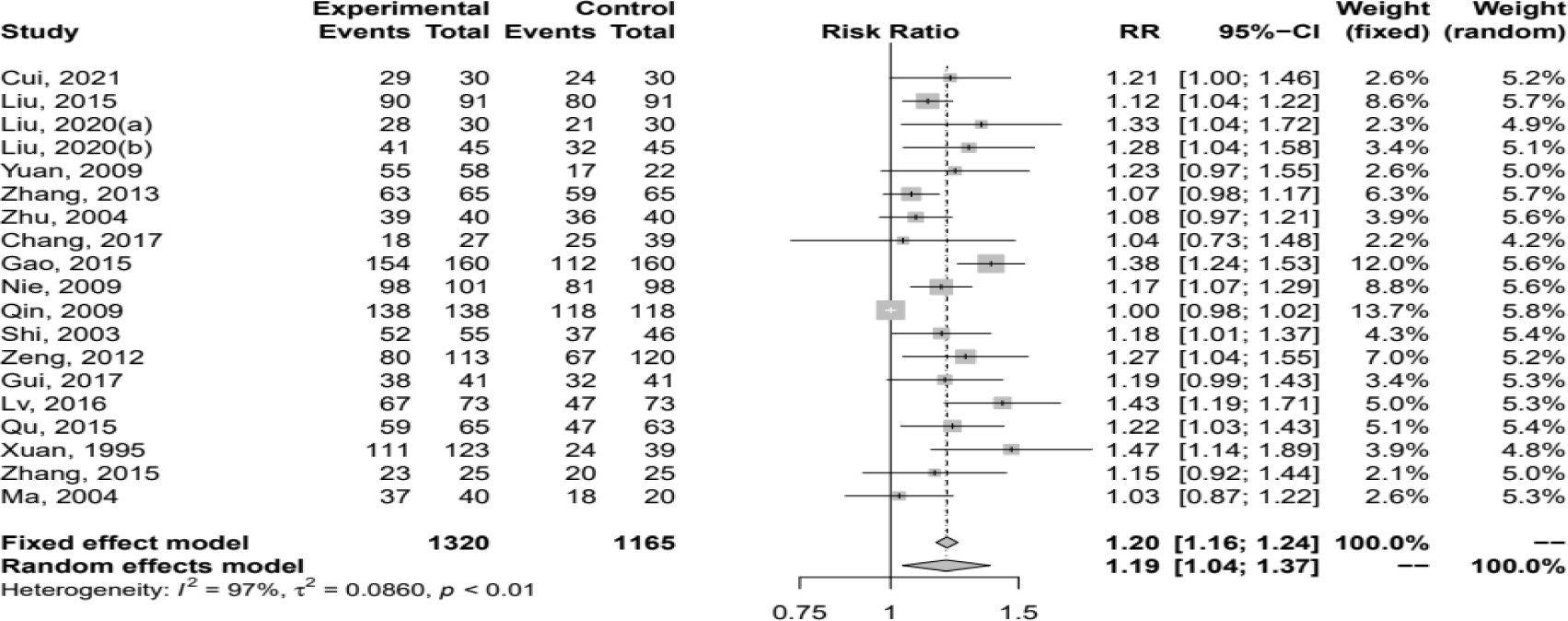
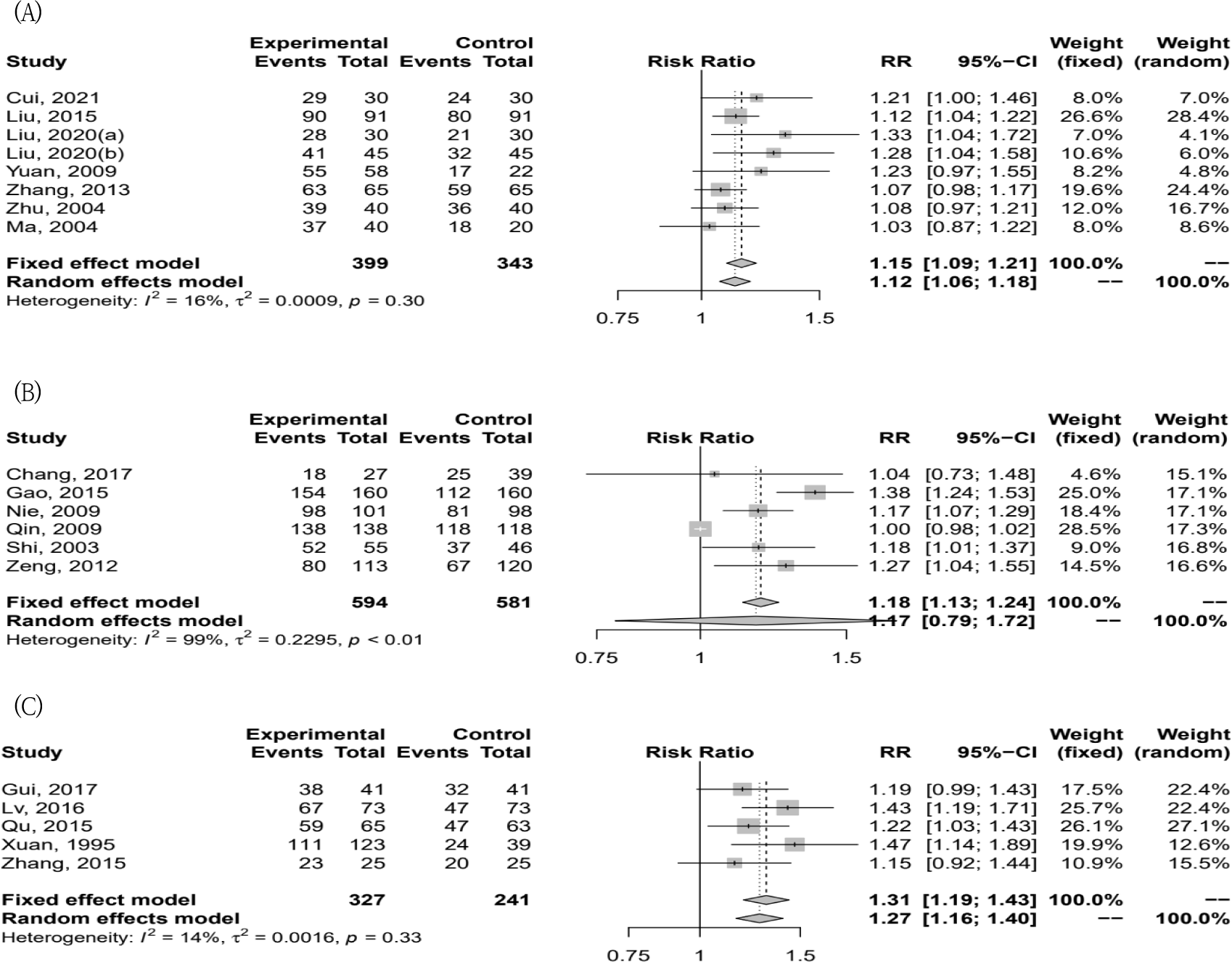
개별 연구 수가 10편 이상의 연구를 사용한 평가 지표에서 메타분석을 실시하였다(Fig. 12). 유효율의 경우 연구가 누적될수록 Risk ratio 1.24로 수렴되는 경향을 보였으며(Fig. 12A), 염증성 병변 개수의 경우 연구가 누적될수록 좋은 효과를 나타내었다(Fig. 12B).
10편 이상의 연구에서 사용된 평가 지표를 대상으로 Sensitivity plot을 확인하고 개별 연구의 이질성과 영향력을 확인하기 위해 Baujat plot을 같이 확인하였다(Fig. 13). 유효율의 경우 Gao(2015)35), Zhang (2020)38)의 연구가(Fig. 13A, B), 염증성 병변 개수의 경우 Samaneh(2020)33), Yang(2021)34)의 연구가(Fig. 13C, D) 다른 연구에 비하여 이질성과 영향력이 서로 비례하는 경향이 강한 것을 알 수 있었다.
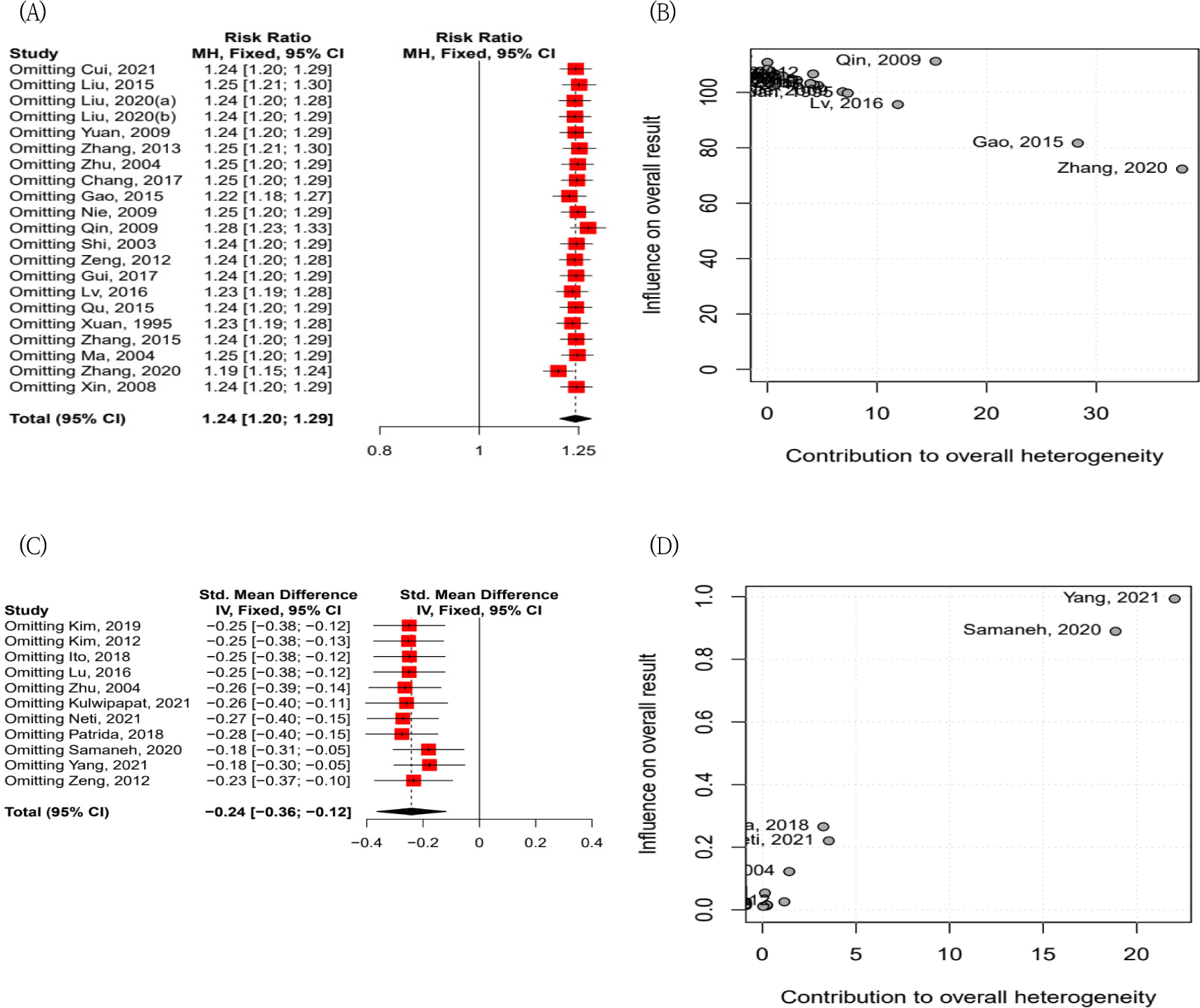
출판 비뚤림은 시각적 평가를 위해 Funnel plot을 시행하였으며, 개별 연구 수가 10개 이상의 연구를 사용한 메타분석에서 확인하였다. 통계적 검정은 Egger’s regression을 통해 검토하였다. 유효율과 염증성 병변 개수 항목에서 각각 p=0.6202, p=5.491e-06이었으며, 유의확률이 통계적으로 유의하지 않으므로 유의수준 0.05에서 Small study effect가 없다는 귀무가설을 기각하지 못하였다. 이와 같은 결과를 바탕으로 Funnel plot에서 비대칭이 나타나지 않으며 출판 비뚤림이 없다고 판단하였다(Fig. 14).
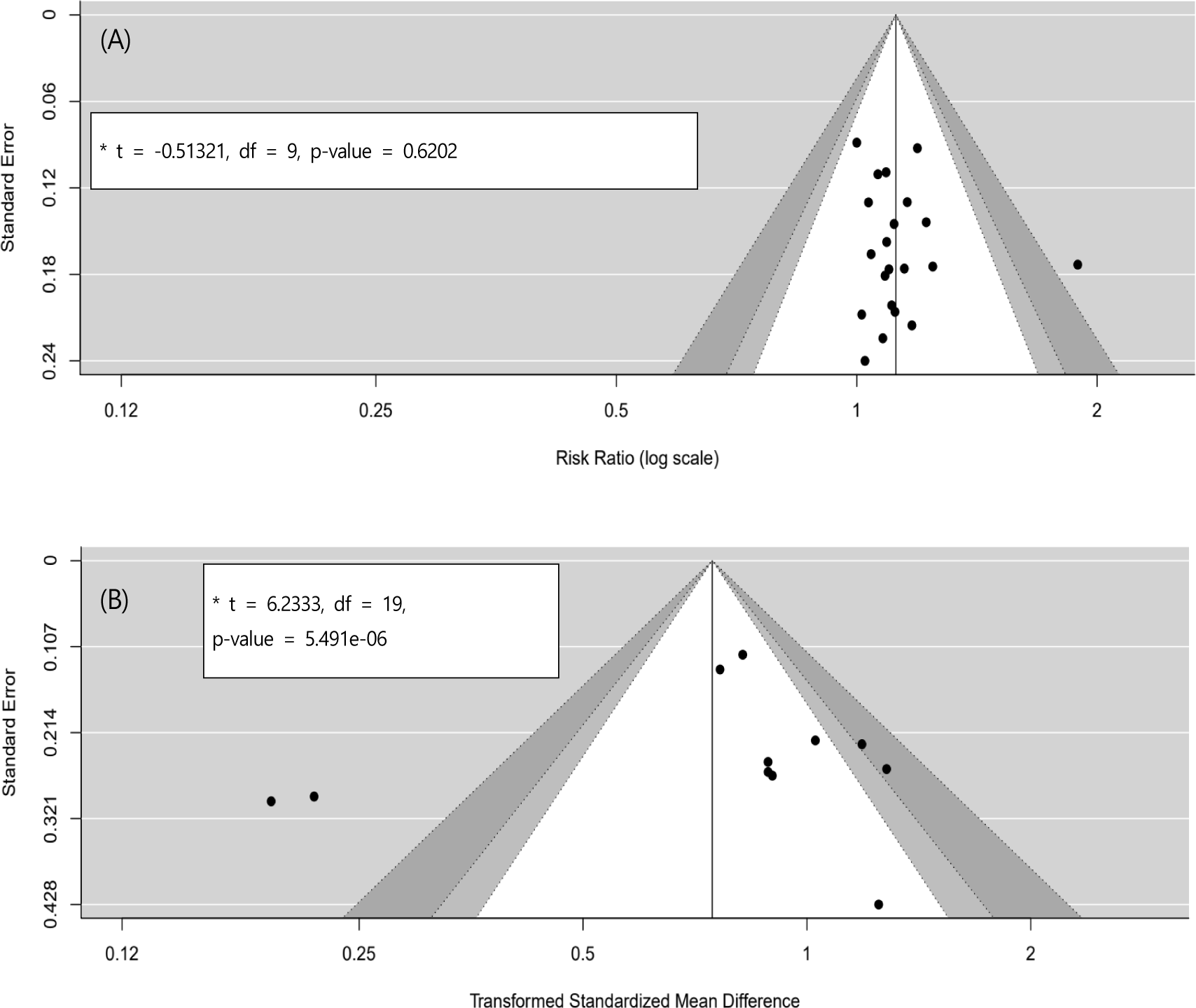
연구에 사용된 전체 본초의 개수는 119개였으며, 5회 이상 사용된 본초는 20개였다. 중재 방법별로 나누어 보면 OHM 군에서 본초는 71가지가 사용되었고, EHM 군에서 총 40가지가 사용되었고, OEHM 군에서 총 64가지가 사용되었다. 연구 전체에서 가장 많이 사용된 본초는 黃芩으로 17회 사용되었으며, 다음으로 連翹가 15회, 甘草가 14회, 丹蔘, 蒲公英이 11회, 金銀花 10회, 大黃 7회, 當歸, 白芷, 白花蛇舌草, 桑白皮, 石膏, 地黃이 6회, 牡丹, 防風, 芍藥, 川芎, 梔子, 黃連, 黃柏이 5회로 다용되었다.
Ⅳ. 고 찰
본 연구는 여드름 환자를 대상으로 한 무작위 배정 임상연구 34편에 대하여 체계적 문헌 고찰과 메타분석을 실시하여 여드름에 대한 한약 치료의 임상적 효과를 살펴보고자 하였다.
본 연구에서 연구 대상으로 정한 34편의 연구에서 여 드름의 치료 효과를 평가하기 위한 지표로 35개의 방법이 사용되었으며(Table 2), 그중에서 3편 이상의 연구에서 중복되어 사용된 8가지를 분석 대상으로 정했다. 여드름의 평가에 있어서 임상적으로 많이 사용되는 기준은 환자의 만족도, 염증성 병변 개수, 비염증성 병변 개수, 연구자의 호전도 평가, 환자의 삶의 질, 기계를 이용한 피부 진단, 재발율로 나타났다.
IGA는 연구자의 주관적 평가로 환자의 호전도를 5단계 척도로 0(Clear)에서 4(Severe)로 평가하는 방법이며, VISIA49)는 기계를 이용한 피부의 진단기로 여드름 피부 상태를 객관적으로 평가 할 수 있는 방법이다(Fig. 8). 본 연구에서 IGA(Fig. 7)와 VISIA(Fig. 8) 모두 통 계적 유의성을 나타내지는 못하였다. 이외에도 사용 빈도는 적었으나 주목해볼 필요가 있는 진단 지표가 Skin Hydration이다. 피부의 수분도는 피부 타입별로 중요한 치료 요점이 될 수 있으므로, ‘경피 수분 손실(TransEpidermal Water Loss, TEWL)’을 측정하는 것은 비침습적 정량적 방법으로 임상 평가에 유용하며, 피부의 수분도를 통해 피부 타입의 평가가 가능하므로 여드름의 연구에서 필수적으로 확인되어야 할 진단 기준이라 사료된다50).
환자들이 작성하는 주관적인 평가 지표 중 삶의 질 평가 설문지인 DLQI는 10가지 문항으로 구성되어 있 으며, 4단계 척도로 평가를 하여 총점이 높을수록 삶의 질이 많이 저하되어 있다고 본다. 여드름 치료는 단순히 피부의 치료가 아니라 높은 삶의 질을 위해 치료해야 할 이유가 있음을 의미한다.
여드름이라면 가장 두드러지는 문제는 Inflammatory lesion으로, Samaneh(2020)33)과 Yang(2021)34)의 표준화된 평균 차이(SMD)가 다른 연구에 비해 두드러지게 차이가 있었음을 알 수 있었다. 두 연구 모두 중재 방법은 EHM이었으며, Samaneh(2020)33)의 연구에서 염증성 병변의 개수가 실험군 73.1%, 대조군 6.22%로 감소하면서 통계적인 차이가 크게 나타났고, Yang (2021)34)의 연구에서도 실험군 56%, 대조군 17% 감소로 치료 효과 차이가 크게 나타났다. Samaneh (2020)33)의 연구에서 Gel 형태로 사용하였으며, Yang(2021)34)은 Cleanser로 사용하였다. 두 연구 모두 한약 외용 치료를 활용했다는 특성이 있다.
또한, Effective rate를 본 연구들의 하위그룹 중 대조군 WM과 비교한 연구 19편을 중재 방법별로 나누어 OHM, EHM, OHEM으로 분석한 결과를 보면, EHM 군에서 p<0.01로 통계적으로 유의한 효과를 보인 것을 알 수 있는데(Fig. 11), 앞으로 여드름의 외용 치료에 대한 좀 더 깊은 연구가 필요할 것으로 생각된다.
누적 분석을 통해 시간의 흐름에 따라 순차적으로 효과 크기의 변화 추이를 파악하였다. 여드름 연구 초반에 진행된 연구는 상대적으로 길이가 긴 신뢰구간을 나타내었으나 시간이 지날수록 길이가 줄어드는 경향이 있었으며, 점차 연구 결과가 누적되면서 염증성 병변의 치료에서도 효과가 있음을 확인하였다(Fig. 12).
민감도 분석은 포함된 연구들을 하나씩 제거하면서 변동되는 효과 크기를 관찰하여 영향력이 크고 이질적인 연구를 찾는데 유용한 도구로, 연구 결과의 강건함을 보기 위해 시행하였다51)(Fig. 13). Effective rate를 본 21편의 연구에서 민감도 분석을 시행한 결과 Sensitivityplot에서 Qin(2009)40)와, Zhang(2020)38)의 경우 연구에 변동폭이 가장 컸다. Baujat plot에서 Gao (2015)35), Zhang(2020)38)의 연구가 이질성 대비 영향력이 비례하는 모습을 보였으며, Qin(2009)40)은 이질성은 적어도 영향력은 큰 모습을 나타내었다. Inflammation lesion count를 본 11개의 연구에서 Samaneh(2020)33)과 Yang(2021)34), 두 연구 모두 이질성 대비 영향력이 비례하여 두 연구에 의해 전체 결과가 달라질 수 있으므로 해석에 주의가 필요하다고 보인다.
34편의 연구에서 사용된 본초를 분석한 결과, 가장 많이 사용된 본초는 黃芩으로 분류 중 淸熱燥濕藥에 해당하며, 淸熱燥濕, 瀉火解毒, 安胎 효능이 있어, 화농성 염증 등에 다용되는 약재이다. 전체에서 5회 이상 사용된 20개의 본초 중 石膏, 梔子가 淸熱瀉火藥, 黃芩, 黃連, 黃柏이 淸熱燥濕藥, 地黃, 牡丹, 芍藥이 淸熱凉血藥, 金銀花, 連翹, 蒲公英, 白花蛇舌草가 淸熱解毒藥에 해당하여 다빈도 본초의 60%가 淸熱藥에 해당하였다. 그 외에 白芷, 防風이 發散風寒藥, 川芎, 丹蔘이 活血祛瘀藥, 甘草가 補氣藥, 當歸가 補血藥, 桑白皮가 止咳平喘藥, 大黃이 攻下藥에 속하였다. 이 결과를 통하여 여드름의 치료에 있어서 淸熱을 통한 염증 치료를 중시하되, 發散, 活血祛瘀, 補氣, 補血 등의 약재를 적절히 사용해야 함을 알 수 있었다52).
Risk of bias의 경우, 무작위 배정 순서 항목은 34편의 모든 연구에서 Low risk를 나타내었고 불완전한 결과의 처리 항목은 29편의 연구에서 Low risk를 보였는데, 이는 본 연구의 모든 연구대상이 RCT 연구여서 엄격한 데이터 처리가 이루어진 측면을 반영하는 것으로 사료된다(Fig. 2). 각 논문에서 정확하게 명시되지 않았으나, 저자가 논문을 분석 할 때 High risk로 판단될 만한 근거가 없는 경우 Unclear risk로 판단하였다. 그러나 연구 대상의 다양성이라는 측면에서, 추후에는 무작위 배정 임상연구 이외의 자료에 대한 분석도 시도해 볼 가치가 있으리라 생각된다.
대조군으로 사용된 양약은 Retinoid 계열, Antibiotics 계열, Benzoyl peroxide으로, Retinoid 계열은 비타민 A 유도체이며 복용이나 국소용 도포제로 사용한다. 각질세포의 결합을 감소시키고, 표피 세포의 탈락 주기를 자극함으로서 각화를 정상화하며, 모낭을 열고 미세 면포의 생성을 예방하는 역할을 한다. Isotretinoin은 피지 생성을 감소시켜 간접적으로 P.acnes의 집락 생성을 줄여준다. 흔한 부작용으로는 피부 건조감 증가와 홍반, 작열감, 통증 등이 생길 수 있다. Antibiotics 계열은 Erythromycin, Clindamycin, Tetracycline 등을 복용하거나 국소용 도포제로 사용되며, 항균, 항염 작용으로 여드름 치료에 가장 다용되나, 내성의 문제가 있다. Benzoyl peroxide는 국소용 도포제로 사용되며, 산소를 방출하여 여드름을 유발하는 혐기성 균을 감소시키는 효과가 있으나, 피부 자극과 건조함이 심해질 수 있다53). 이 약물들은 면포 용해 기능과 여드름 균의 증식을 억제하고, 염증 반응을 완화 시키는 효능이 있지만 정도의 차이가 있으므로 종류에 따른 치료군의 효과 평가가 달라질 수 있다. 따라서 향후 양약의 한 종류와 한약의 정확한 치료 효과를 비교하는 연구가 진행되어야 할 것이다.
본 연구를 통하여 여드름의 다양한 평가 지표와 치료 기간, 중재 방법, 사용된 본초 등을 분석함으로써 여드름의 한약 치료 효과를 다양하게 확인하였으며, 국내외 연구를 동시에 분석함으로써 여드름 치료에 사용되는 본초의 다양성과 효과를 볼 수 있었다. 그러나 본 연구에서 대조군에 사용된 양약의 종류가 달라 효과 비교에 오류가 있을 수 있는 한계점이 있다. 또한 여드름은 모낭의 염증반응이 진행되는 활성화된 상태부터 모낭의 염증반응 끝난 여드름 흉터와 같은 비활성화된 상태를 모두 포함함에도 불구하고, 본 연구에서는 활성화된 상태의 여드름에 대해서 한약으로 치료한 연구들만 대상으로 한 한계점이 있다. 따라서 추가적으로 색소침착이나 피부 함몰 등 여드름 흉터를 치료하는 연구까지 포함하여 문헌 고찰과 메타분석이 진행된다면 더욱 의미 있는 연구가 될 것으로 생각한다.
Ⅴ. 결 론
여드름 환자에서 한약 치료의 효과를 본 무작위 배정 임상연구를 통해 체계적 문헌 고찰과 메타분석을 한 결과 한약 치료의 효과를 확인할 수 있었다.
-
질적 분석에 포함된 34편의 무작위 배정 임상연구에서 사용된 여드름 평가 지표는 35개였으며, 3편 이상의 논문에서 사용된 평가 지표는 치료자가 평가하는 Inflammatory lesion count, Non inflammatory lesion count, IGA와 기계 평가인 VISIA, 그리고 환자가 평가하는 Effective rate, DLQI, Recurrence rate이었다.
-
전체 연구에서 보고된 이상반응 중 심각한 이상반응은 없었으며, 연구 종료 후 모두 특별한 치료 없이 호전되었다.
-
무작위 배정 순서(Random sequence generation) 항목은 34편의 모든 연구에서 Low risk of bias를 나타내었고 불완전한 결과의 처리(Incomplete outcome data) 항목은 29편의 연구에서 Low risk of bias를 나타내었다.
-
연구 전체에서 치료 기간은 11일-84일로 평균은 35.1일이었고, 치료 기간이 길어질수록 평가 지표별 분석에서의 이질성이 높아졌다.
-
메타분석에 포함된 30편의 논문을 분석한 결과, OHM, EHM, OEHM의 치료는 염증성, 비염증성 병변의 개수를 감소시키고, 여드름을 치료하는데 유의한 효과가 있었다.
-
연구 전체에서 가장 많이 사용된 본초는 黃芩이었고, 連翹, 甘草, 丹蔘, 蒲公英, 金銀花, 大黃, 當歸, 白芷, 白花蛇舌草, 桑白皮, 石膏, 地黃, 牡丹, 防風, 芍藥, 川芎, 梔子, 黃連, 黃柏 순으로 다용 되었다.
-
淸熱藥이 60%로 가장 많았으며 發散, 活血祛瘀, 補氣, 補血 등의 약재가 주로 사용되었다.
이와 같은 연구 결과와 더불어, 추후 여드름의 한약 외용 치료에 대한 심도 있는 연구가 필요할 것으로 사료된다.







